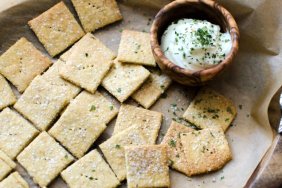Drinking great matcha is not only one of life’s great epicurean pleasures, but it also makes you feel like you’ve just had a yoga class!
By now most of us have heard about the healing powers of green tea, but one type in particular—matcha, a powdered green tea—is especially potent. In fact, 1/4-1/2 teaspoon of matcha is equal to 8 to 10 cups of regular tea in terms of its antioxidant power, which contributes to matcha’s cancer and disease fighting properties.
The powdered tea leaves are used in traditional Japanese tea ceremonies and whisked together with hot (not boiling) water, which means you are ingesting the tea leaves and getting significantly more nutritional benefits than you would with traditional brewed leaf teas. Among the most highly regarded matcha purveyors are Palais des Thés and Harney, which offer high quality teas at reasonable prices that can be enjoyed as is or used in a wide variety of recipes (because of its convenient powder form, matcha can be used in anything from salad dressing to ice cream). Another go-to site for those looking for reliable matcha is Breakaway Matcha, which was started by author and chef Eric Gower. A true matcha connoisseur, he specializes in sourcing, custom blending and distributing the highest-quality matcha.
We spoke with Gower to find out about matcha’s flavor profile, why we should all be drinking it and how to shop for the best tea.
theFashionSpot: How does matcha compare to traditional green tea in flavor?
Eric Gower: Matcha, when made properly, is much more robust than traditional green tea. The mouthfeel is completely different because we are consuming the tea leaves. Not steeping them creates a unique mouthfeel and rich, robust flavor absolutely full of umami (the fifth taste, along with sweet, salt, sour and bitter, is often translated from the Japanese as “savory” or “brothy”). It’s a heady taste, almost meaty or miso-y in its brothiness, with strong notes of pureed baby vegetables. It’s really more like a nutritious soup than a tea.
tFS: Are there differences in flavor between matchas and, if so, to what are they due?
EG: Yes, absolutely. The differences primarily come from a few key things: terroir (the conditions in which the tea is grown), harvesting techniques and final blending. Some lower-quality matcha is produced using many parts of the plant, including older leaves and even stems. The highest-quality matcha will always be new-growth only; only the two newest leaves/shoots are picked and de-stemmed. It’s an extremely labor-intensive process, one that suits the obsessive qualities of traditional Japanese farmers quite well. Highest-quality matcha flavor is dominated by smoothness, some sweetness and a great deal of umami. There should be no bitterness at all. In my opinion, people can fool themselves by equating some degree of bitterness (often major bitterness) with quality matcha. Traditional tea schools in Japan are of no help here, as the tea often served in ceremonial environments is quite bitter and lower quality, which is one reason why one is given an artfully crafted sugar cube to take with the matcha, to sweeten the pill almost literally. You should be able to continue to taste heavenly matcha notes for a good 20 or even 30 seconds after swallowing it.

tFS: What are the nutritional benefits? And how often do you have to drink it to get them?
EG: Where to begin? The body of research on matcha and its medicinal uses in Japan is vast compared with elsewhere, but these health benefits are increasingly becoming better known here as well. Matcha is full of catechin polyphenols, compounds with high antioxidant activity that are many times higher than any of the current “superfoods” like acai berry, gojiberry, pomegranate, dark chocolate, etc. Research studies show that these compounds offer protection against many kinds of cancer. Matcha also helps to reduce bad cholesterol in the blood, prevent cardiovascular disease, stabilize blood sugar levels, reduce high blood pressure and, in general, strengthen the immune system. Because matcha is taken whole, it has lots of dietary fiber with only around 10 calories per serving.
tFS: What should people look for when deciding on which one to buy?
EG: It’s hard to purchase matcha without actually looking at it, because the packaging typically used for matcha is sealed—it has to be air-tight and light-proof, otherwise degradation sets in rather quickly (the enemies of matcha are light, heat and air). Making matters worse, much of the packaging is typically in Japanese, rendering it unintelligible for most people. But even for folks who can read Japanese, info on the labels rarely help; the label may tell you where it was processed, the name of the company and some basic nutritional information if you’re lucky. So, what to do? There really is no option except to buy from a trusted source, someone who has demonstrated very good knowledge of matcha. Price is almost always an indicator of quality, because great matcha is inherently on the expensive side (at least compared with other teas) due to the labor-intensive nature of the process. There are no shortcuts to producing great matcha, and there is certainly no “bargain” matcha on the market; you definitely get what you pay for. That said, there is no point in using an expensive, rare matcha to cook with or use in a smoothie. The heat and the addition of fats and sugars will more or less obviate all the special qualities of the more expensive matcha. So if you’re planning on making lattes, smoothies, cakes, etc., you should avoid the rarer matcha and purchase a vastly less-expensive culinary matcha, which will be better suited to the purpose and way easier on the wallet.
tFS: To that point, what is a “reasonable” amount to pay given how greatly prices vary?
EG: What’s a reasonable amount to pay for a bottle of wine? Same question with matcha. Some people buy only two-buck chuck, others think $10 is reasonable for a bottle of wine, others think $50 is the threshold for a good bottle of wine. And then you have the collectors and oenophiles who’ll pay hundreds and even thousands of dollars for a single bottle of exceptional and rare wine. It’s the exact same scenario with matcha. Culinary matcha is what you want if you’re using matcha as an ingredient, and a reasonable amount to pay might be around $35 for 100g. On the other hand, if you’re going to sip matcha as you might a great wine and really enjoy the umami and long, long finish, there are plenty of people (mostly in Japan, but this is changing quickly) who don’t mind paying $100 or even $500 for a tin of truly exceptional matcha. Here at Breakaway Matcha we’ve tried to identify the most talented growers in Japan who produce exceptional matcha at different price points. Our hyperpremium sipping matcha starts at $45 for a 30g tin (30 servings), which comes out to a mere $1.50/cup, which is cheaper than the house coffee at Starbucks. A rarer, more umami-laden blend we developed costs just $65/tin, and we have two more very rare and special blends for $85 and $105/tin. While $105 might sound like a lot for tea, it’s still just $3.50/serving for an epicurean experience like no other, and one that happens to also be one of the healthiest substances on earth in terms of phytonutrients. You feel simply incredible after having a cup, it’s a high like nothing else. You can’t even order a bad glass of wine for $3.50 these days. It really should be kept in this kind of perspective. Ever buy a round for friends in a bar? Goodbye $60 or more! And for what? Bad, headachey, calorie-laden alcohol? Drinking great matcha is not only one of life’s great epicurean pleasures, but it also makes you feel like you’ve just had a yoga class!





